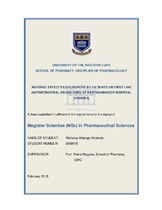| dc.contributor.advisor | Mugabo, Pierre | |
| dc.contributor.author | Mutenda, Nicholus Mbangu | |
| dc.date.accessioned | 2015-10-06T11:35:16Z | |
| dc.date.available | 2015-10-06T11:35:16Z | |
| dc.date.issued | 2015 | |
| dc.identifier.uri | http://hdl.handle.net/11394/4549 | |
| dc.description | >Magister Scientiae - MSc | en_US |
| dc.description.abstract | Adverse effects are a significant factor that determine how long patients will tolerate a given antiretroviral drug regimen. They also influence treatment options, and play an important role in the much needed adherence to treatment by patients on Highly Active Antiretroviral Therapy (HAART). This study is aimed at understanding adverse effects experienced by patients on the first line antiretroviral therapy at Keetmanshoop Hospital in Namibia. Methods : A retrospective quantitative method was used to review records of patients on first line antiretroviral treatment who started treatment between November 1st 2007 and December 1st, 2008 and followed up until they reached 36 – 48 months on treatment. Records of 94 patients were found eligible to be included in the study. Data was analysed using Stata 12 data analysis software. Results : The most reported adverse effect was musculoskeletal disorders (25%) whereas headache (16%) was the least reported. Low haemoglobin (78%) was the most common recorded hematologic adverse effect whereas low red cell distribution width and low mean platelet volume were the least recorded adverse effects (0%). A Male patient was more likely to experience a low haemoglobin levels compared to a female patient (adjusted OR: 3.29, 95% CI: 1.3 – 8.3). A male patient was found to be 64% times less likely to experience a higher mean cell haemoglobin compared to a female patient (adjusted OR. 0.31, 95% CI: 0.11 – 0.87). A patient on nevirapine was more likely to experience an elevated creatinine level compared to a patient on efavirenz (adjusted OR; 36.0, 95%CI: 2.02 – 62.5). At baseline, a patient who had prior exposure to ART had an 81 times (adjusted OR: 81.4, 95%CI: 5.3 – 119, p-value=0.00) increased odds of experiencing a high mean cell volume (MCV) compared to a patient with no ART exposure. A patient with a higher CD4 count was also less likely to experience a low hemoglobin compared to a patient with low CD4 count (adjusted OR; 0.31, 95% CI: 0.12 – 0.77). The author recommends further studies with higher sample size to confirm whether higher creatinine levels are more prevalent in patients on nevirapine compared to patients on efavirenz; this will have clinical implications especially in patients with impaired renal system. Antiretroviral treatment increases chances of developing macrocytosis anaemia; clinical implication of this condition may need to be investigated. | en_US |
| dc.language.iso | en | en_US |
| dc.publisher | University of the Western Cape | en_US |
| dc.subject | Macrocytosis anaemia | en_US |
| dc.subject | Highly active antiretroviral therapy | en_US |
| dc.subject | Antiretroviral Therapy, Highly Active | en_US |
| dc.subject | Nevirapine | en_US |
| dc.title | Adverse effects experienced by patients on first line antiretroviral drugs used at Keetmanshoop Hospital (Namibia). | en_US |
| dc.rights.holder | University of the Western Cape | en_US |

